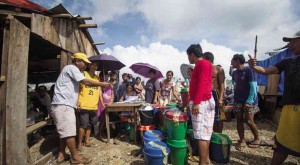PH Catholics make lifelong sacrifice after typhoon
OPONG – Returning to their destroyed village after a catastrophic typhoon that killed thousands in the Philippines last year, a weary band of Catholics vowed a lifelong sacrifice to thank God for saving them.
They had walked through the streets of their hometown for three consecutive days before the storm with icons in hand while praying and asking the Lord to spare them from the looming disaster.
Although giant ocean surges that swept through their coastal village destroyed many homes, and some of the most powerful winds recorded on land tore roofs off others, all of the roughly 3,500 residents of Opong survived.
The devotees’ ensuing vow was to perform a religious procession similar to their pre-typhoon marches at least twice a week for the rest of their lives.
“We want to thank the Lord for giving us a second chance at life. We want to thank Him for giving us the strength of our faith,” Elsie Indi, a mother-of-four, who is one of the regular members of the procession, told AFP after a recent march.
Article continues after this advertisementTen days after Super Typhoon Haiyan hit, AFP photographer Philippe Lopez took a dramatic photo of Indi at the head of the Opong procession that came to symbolise the devotion, hope and resilience of many typhoon survivors.
Article continues after this advertisementThe image won the Spot News category in the prestigious World Press Photo Awards, and was named by Time magazine as one of the top 10 images of 2013.
Lucky escape
Indi, 42, her invalid husband and four children fled their home just after dawn on November 8 as knee-deep water rushed in, racing ahead of the torrent to a rice paddy at the base of a mountain about one kilometer away.
They, along with many other residents of Opong, sheltered in the muddy field for about six hours, waiting for the storm surges to recede into the Pacific Ocean and the intense rain to pass.
During that time, the typhoon killed or left missing about 8,000 people in towns and cities of the central Philippines near Opong, making it the country’s deadliest storm on record.
“Everyone in Opong survived, we can thank God for that,” Indi said.
During the most chaotic and desperate period immediately after the typhoon, some of the residents of Opong held their processions twice a day. The procession, involving anywhere from a few people to more than 20, took more than an hour.
Such acts of devotion are common even outside times of disaster in the Philippines, where about 80 percent of the nation’s 100 million people are Catholic thanks to a Spanish colonial heritage.
In what is known locally as a “panata,” devotees promise to God to make some form of sacrifice as repayment for a prayer that has been granted.
In some of the most extreme and famous panatas, devotees around the country have themselves nailed to crosses or whip their backs into a bloody mess of red flesh every Good Friday.
“After being saved, we had to make some sacrifices. The procession is one form of sacrifice,” said Virginia Piedad, 47, a primary school teacher who came up with the idea for the Opong community’s panata.
Asked when the Opong residents would give up the procession, Piedad and Indi insisted they would continue their hour-long marches every Wednesday and Saturday with the same Jesus statues in their arms until they died.
Endless anxiety
But despite the relentless giving of thanks, life for Indi and many others in Opong often feels like an abyss of anxiety and exhaustion.
The iron-sheet roofing, windows and steel trusses of Indi’s cramped home were torn away or badly damaged during the storm, and she has no means to replace them.
She estimates it would cost more than 150,000 pesos ($3,300) to repair the house, an impossible amount when her work as a market vendor brings in most of her family’s only income.
Indi’s husband, Roel, has not worked for six years because of severe diabetes, while three of her children are still studying. A fourth child, a 21-year-old son, earns about 200 pesos a day making concrete blocks for houses.
Indi said she had to borrow 15,000 pesos from a local lender to reopen her stall after Haiyan, with an interest rate of 33 percent over the term of the six-month loan adding to almost unbearable financial pressure.
“We are begging for help. We need money to rebuild our house,” Indi said as she stood at the entrance to their ruined home and cried.
Nevertheless, Indi insisted she and the other residents of Opong were fortunate simply to be alive, and that was reason enough to continue with their religious procession.
“We are thankful… and it gives us comfort,” she said.
RELATED STORIES
No end in sight for ‘Yolanda’ widow’s woes
